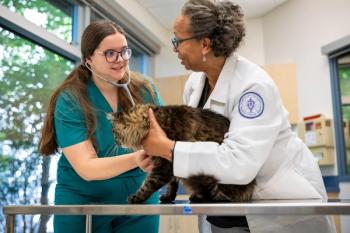
- dvm360 October 2019
- Volume 50
- Issue 10
Study: Is there a veterinarian shortage? Yes. Could we fix it immediately? Yes.
Veterinary economist crunches the numbers to quantify the difference between open veterinary positions and DVMs seeking employment.
Just a few years ago, the buzzword associated with the market for veterinarians was “oversupply”-there were
Regardless of terminology, the pendulum has clearly swung back the other direction, and the industry is now using the term “shortage”-there simply
The study, “The Current U.S. Employment Market for Veterinarians,” was conducted under the auspices of Dr. Lloyd's Animal Health Economics consulting company-he recently retired from his position as dean of the University of Florida College of Veterinary Medicine-and commissioned by the Animal Policy Group lobbying and consulting firm, which has ties to Banfield.
“This study is meant to provide a snapshot in time,” Dr. Lloyd told corporate CEOs, nonprofit presidents, association executive directors and other veterinary industry leaders who made up the group of summit attendees. “The goal was to quantify the shortage of veterinarians using a ‘one point in time' analysis comparing the number of open positions for veterinarians to the number of applicants seeking employment.”
To provide this “snapshot,” Dr. Lloyd looked at the number of veterinary job postings on
Dr. Lloyd next looked at the number of candidates applying to veterinary schools: Were enough of them of sufficient caliber to fill that many vacant positions in the profession? On a basic level, he asked, could veterinary schools accept enough high-quality students to eliminate the shortage? His answer is yes.
In 2018, he found, 51% of veterinary school applicants received an offer from at least one school. Among those who did not, his research showed, between 2,000 and 3,000 applicants exceeded minimum levels of academic achievement-as determined by grades and GRE scores-compared to those in the pool who were accepted. While being careful not to draw too many cause-and-effect conclusions, Dr. Lloyd also pointed out that first-generation college students and non-white applicants were significantly less likely to receive an offer.
“Schools have to ask themselves the following question,” Dr. Lloyd said. “Are we recruiting students who will be successful in veterinary school or successful in veterinary practice?”
So, in very broad terms, Dr. Lloyd concluded-and leaving aside such important issues as any admission process weaknesses, the expense associated with educating veterinarians and massive levels of student debt-veterinary schools could theoretically eliminate the shortage by accepting more qualified candidates.
Articles in this issue
about 6 years ago
Fetch dvm360 keynote sneak peek: The secret to work-life balanceabout 6 years ago
10 vet tech superstars to followabout 6 years ago
Human surgeons operating on dogs: When good intentions aren't enoughabout 6 years ago
To prevent suicides, Banfield wants veterinary professionals to ASKover 6 years ago
Letters to dvm360: Sounding off on DCM dilemmaover 6 years ago
Eleanor Green joins Animal Policy Group, will leave Texas A&Mover 6 years ago
Veterinary products now and for future wowover 6 years ago
A horse vet goes to the airport ...over 6 years ago
Build the bond to reach millennial pet ownersover 6 years ago
AVMA: More veterinary technicians, higher practice efficiencyNewsletter
From exam room tips to practice management insights, get trusted veterinary news delivered straight to your inbox—subscribe to dvm360.





